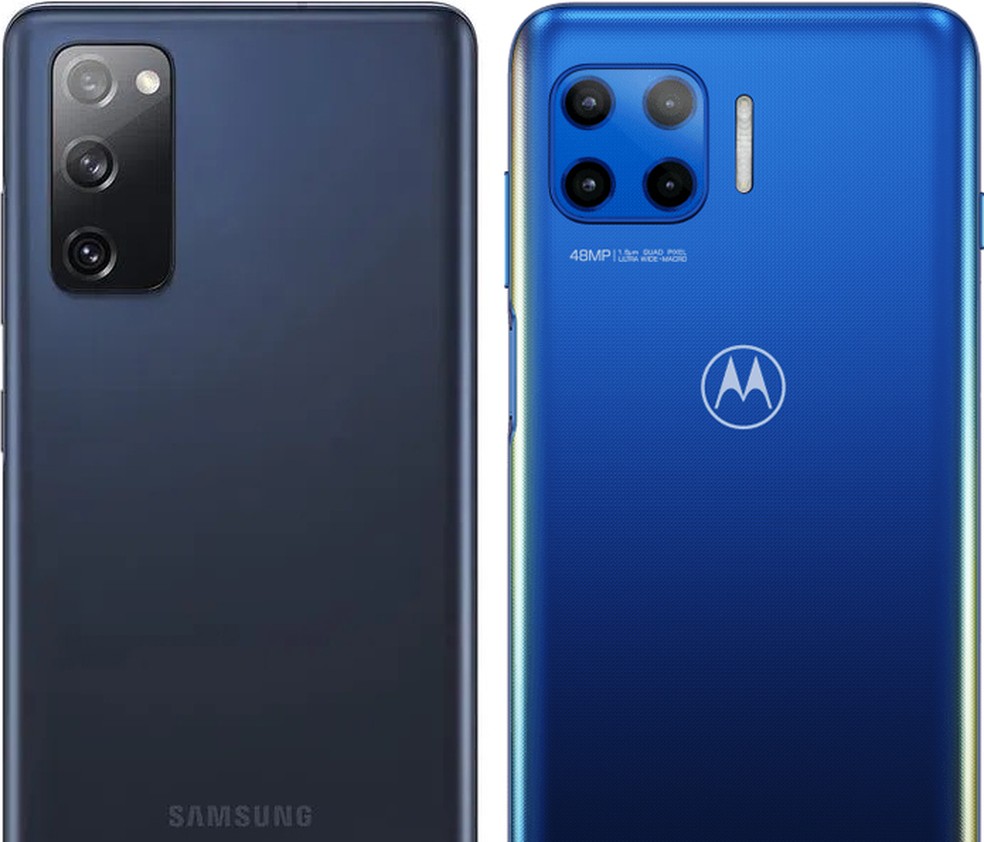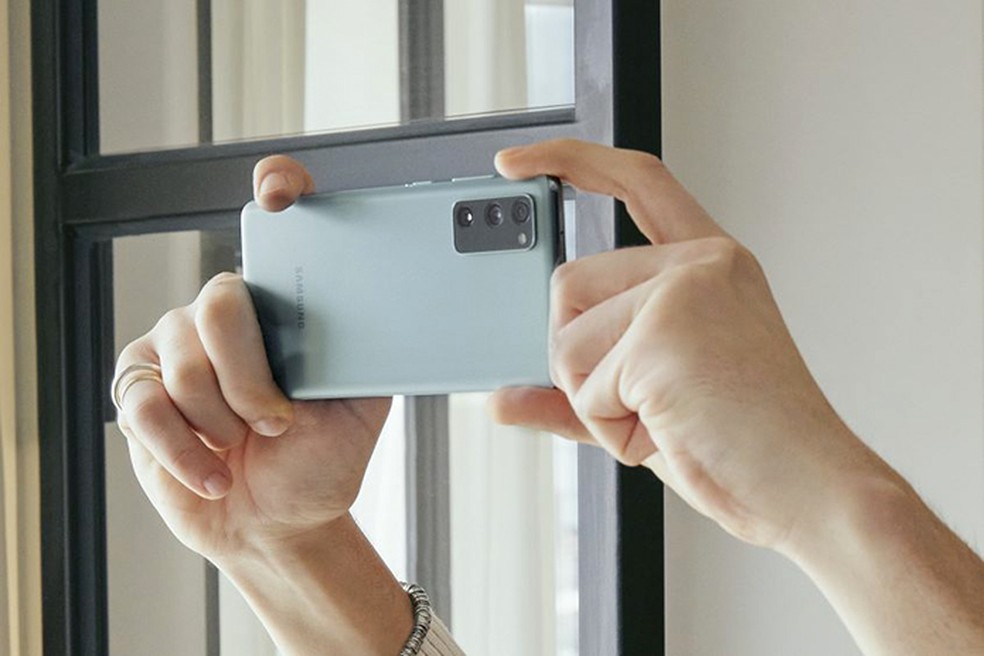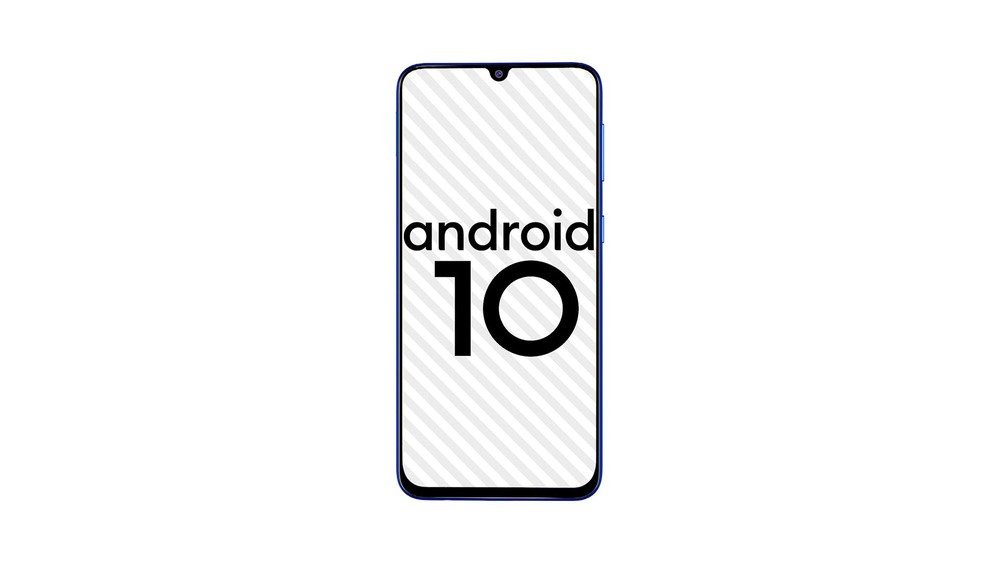Galaxy S20 FE and Moto G 5G Plus are premium feature phones released in 2020 by Samsung and Motorola, respectively. Smartphones have attributes that appeal to different types of consumers, even though they have similar specifications. The number of cameras and the built-in processor can be a determining factor for the choice.
Datasheet: Moto G 5G Plus vs Galaxy S20 FE
| Specifications | Motorola Moto G 5G Plus | Samsung Galaxy S20 FE |
|---|---|---|
| Launch | July 2020 | November 2020 |
| Current price | $270 | $599 |
| Screen | 6.7 inches | 6.5 inches |
| screen resolution | Full HD+ 21:9 (1080 x 2520 px) | Full HD+ 21:9 (1080 x 2400 px) |
| Processor | Snapdragon (octa-core up to 2.3GHz) | Snapdragon (octa-core up to 2.84 GHz) |
| RAM | 8 GB | 6 and 8 GB |
| Storage | 128GB | 128 and 256 GB |
| Memory card | Micro SD up to 1TB | MicroSD up to 1TB |
| Main camera | Quad Camera: 48, 8, 5 and 2 MP | Triple Camera: 12, 8 and 12 MP |
| Front camera | Dual Camera: 16 and 8 MP | 32 MP |
| Battery | 5,000 mAh | 4,500 mAh |
| Operating system | Android 10, upgradeable to 11 | Android 10, upgradeable to 11 |
| Dimensions and weight | 168.3 x 74 x 9.7 mm; 207 g | 159.8 x 74.5 x 8.4 mm; 190 g |
| Available colors | blue and lilac | Navy blue, white, lavender, mint, red and orange |
Screen and design
The Super AMOLED screen present in Samsung’s devices is known in the market for providing more vibrant colors and higher sharpness than in IPS LCD screens, present in Motorola. In addition, the refresh rate of the Galaxy can reach higher levels, operating between 60 and 120 Hz, while the Motorola only reaches 90 Hz, which results in a smoother screen, especially for gaming.
Overall, the Moto G 5G Plus is larger than the Galaxy S20 FE. Its screen is 3% larger (6.7 inches versus Samsung’s 6.5), the device is 9% heavier (207 g versus 190 g), and the body is 9% larger (almost 1 cm taller, as well as thicker). It is a small difference, but one that should be felt in the hand when using the device.
Another difference is the material used in the construction of smartphones. For being a cheaper version of the 2020 flagship, Samsung opted to replace the glass with plastic but kept the metal sides. This change is aimed at lowering the production cost of the device. Motorola, on the other hand, has a glossy plastic back and sides, a material that offers less protection and tends to have fingerprints all over it.
Both devices have a biometric reader, but Samsung’s is located in the lower corner of the screen, mounted below the display, while Motorola’s is on the right-side button, below the volume. Both should respond quickly when pressed, and it becomes a matter of taste to choose which one is better. Another predilection may also be the front camera notch, which on Samsung’s device is centralized, while on Motorola’s device it is on the left corner of the screen.
Camera
The Galaxy S20 FE’s main camera has a dual-pixel sensor, made to capture more light, which provides better detail and color in night photos. The sensor also features optical stabilization (OIS) to prevent camera shake, provide more accurate images with less blur. In addition, the rear set also has three times optical zoom, which, added to the digital zoom, provides up to 30 times zoom.

Optical stabilization is more efficient than digital stabilization (EIS) because it works together with the camera’s sensors to improve the images produced. In the same way, optical zoom is better than digital zoom because it moves the camera lens to get the required zoom, ensuring true approximation. Overall, these are two features that make the difference for users looking for good cameras in a device.
The Samsung shoots at a speed of up to 60 frames per second (fps) in 4K resolution on both the front and main camera. This resolution is befitting a premium mid-range device, while videos produced at 60 fps should show better fluidity, having a superior result when capturing moving images. The set also features an ultra-wide camera, with a 123° angle, which increases the area coverage of the photo.
The set of cameras present in the smartphone is:
- 12 MP main camera (f/1.8)
- 12 MP ultra-wide (f/2.2)
- 8 MP telephoto (f/2.4)
- 32 MP front camera (f/2.2)
The Moto G 5G Plus features Quad Pixel technology in the front and rear cameras, which makes the sensor much more light-sensitive than a dual-pixel sensor because it combines four pixels into one. The combined pixels should result in better-quality photos. It is worth noting that the Moto G 5G Plus has a 48-megapixel (MP) sensor, which should provide much larger images. The downside is that the video stabilization is digital, which may turn out worse results than optical stabilization.
The two ultra-wide cameras, front, and rear have a 118˚ angle for capturing wide images. In addition, the set features portrait mode to add blur to the background of photos and night mode, for very low light environments. Motorola offers the option to shoot in Full HD at 60 fps or in 4K at 30 fps, with 4K not available in conjunction with 60 fps. The features of shooting in 4K or shooting at 60 fps are only available on the main camera.
The set is composed as follows:
- 48 MP main camera (f/1.7)
- 8 MP Ultra-wide (f/2.2)
- 5 MP Macro (f/2.4)
- 2 MP depth sensor and f/2.4 aperture
- 16 MP (f/2.0) front-facing camera
- 8 MP Ultra wide front sensor (f/2.2)
The camera sets of the two smartphones also feature HDR, autofocus, digital stabilization on the front cameras, and flash on the rear cameras. And it’s worth mentioning, the Motorola’s flash is dual-LED, which provides more luminosity for photos.
The specifications of each device indicate that while the Motorola smartphone has more cameras with useful features such as the front ultrawide camera and the possibility of Macro shots, the Samsung smartphone offers unique attributes. These, in turn, are found on high-end devices, such as optical stabilization, optical zoom, and video capture uniting 4K at 60 fps speed.
Performance and storage
The Galaxy S20 FE has Qualcomm’s eight-core Snapdragon 865 – one core operates at a frequency of up to 2.84 GHz, three operate at 2.42 GHz, and four operate at 1.8 GHz, together with an Adreno 650 graphics chip. The set is a long-standing desire of fans of the brand. Snapdragon is known for good performance and low power consumption.

The Moto G 5G Plus, meanwhile, has an eight-core Snapdragon 765 processor, also from Qualcomm – one core runs at a frequency of up to 2.3 GHz, one runs at 2.20 GHz, and six runs at 1.8 GHz. Motorola’s graphics chip is a 2019 Adreno 620 GPU. Although the Galaxy S20 FE’s processors are noticeably superior in numbers, the Snapdragon processor-equipped versions tend to score better on battery savings.
Motorola’s choice to use a 2019 graphics chip, while the two Samsung versions rely on 2020 components, should directly affect the performance of the device when compared to the Galaxy S20 FE. Websites specializing in mobile graphics chips show that the GPUs present in Samsung outperformed those offered in the Moto G 5G Plus.
The Moto G 5G Plus is sold with 128 GB internal storage and 8 GB RAM. The Galaxy S20 FE is sold in two options: one with 128 GB of internal storage and 6 GB of RAM, and another with 256 GB of internal storage and 8 GB of RAM. Both accept microSD memory cards up to 1 TB.
Battery

If in performance the Moto G 5G Plus falls behind, it is in battery that it stands out. It is 5,000 mAh, which Motorola claims, via its official website, can last up to two days. The device is sold with a 20-watt high-speed charger. The Galaxy S20 FE, on the other hand, has a 4,500 mAh battery. According to Samsung, the battery should last all day, even using it for gaming, due to the smart power-saving features.
The S20 FE also features high-speed wireless charging (15 Watts) and can be used as a power bank to charge other devices. The Galaxy S20 FE comes with a 25-Watt high-speed charger, which allows you to charge 50% of the battery in just 30 minutes.
Android Version

Both devices leave the factory with Android 10. The Samsung model already has an update to Android 11, the latest stable version of Google’s system. Another available update layer is for One UI 3.0, visual customization created by Samsung itself and made available to users in February of this year.
The Motorola handset will also be able to be updated to Android 11, as Motorola has already released the list of phones that will receive this update. However, even though the Moto G 5G Plus is one of those covered, there is no prediction of when the update will be released. Motorola has also not informed whether it will receive future updates, so it is not possible to say whether the device can count on Android 12, the version recently announced by Google.
Samsung’s handset is less susceptible to security breaches since Samsung has committed to updating phones starting in 2019 for at least 4 years. This may indicate survival of the Galaxy S20 FE since it was released in 2020 and should have updates for another two years.
Additional features
5G is one of the differentiators of the Motorola Moto G 5G Plus. The standard is a natural evolution of the 4G Internet speed, being up to 50 times faster than the current network.
Both devices have Wi-Fi in the 2.4 GHz and 5 GHz bands, available in more modern routers, but only the Galaxy S20 FE can use Wi-Fi 6. The standard, faster and more secure, is absent in the Moto G 5G Plus.
GPS and NFC are present on both devices. Both also use USB-C input, but the Samsung’s connector is more modern, featuring standard 3.2, while the Motorola uses a 2.0 input, which implies lower data exchange speed than seen on the Galaxy. Nevertheless, the Bluetooth of the Moto G 5G Plus is better, with 5.1, more precise and stable than the 5.0 version of the S20 FE.
Another advantage of the Galaxy is in terms of sound: the device has stereo sound with AKG quality, a brand that is also responsible for the headphones that come in the box. It is worth noting that the smartphone has no 35 mm jack, requiring an adapter to use the accessory with another device. The Moto G 5G Plus has kept the headphone jack, which offers stereo sound. The device also has a radio, absent in the Galaxy.
The Galaxy S20 FE also has features such as Always-On Display, which displays information on the screen even when the phone is turned off, USB On-The-Go, which allows you to connect USB devices such as pen-drives to the phone, Samsung Pay, Samsung’s digital wallet, and Bixby, the brand’s Artificial Intelligence. The Moto G 5G Plus benefits from a dedicated button for Google Assistant, which allows you to request information or execute commands on the device using only your voice.
The Motorola Moto G 5G Plus has a hydrophobic coating that repels water and is sold in blue and lilac colors. The Galaxy S20 FE is IP68 certified for dust and water resistance (up to one and a half meters for 30 minutes) and has a wider range of colors: navy blue, white, lavender, mint, red, and orange.
Pricing and Availability
The Motorola Moto G 5G Plus and the Samsung Galaxy S20 FE are 2020 handsets that are available for purchase on Amazon for $280 and $599, respectively.
This post may contain affiliate links, which means that I may receive a commission if you make a purchase using these links. As an Amazon Associate, I earn from qualifying purchases.

